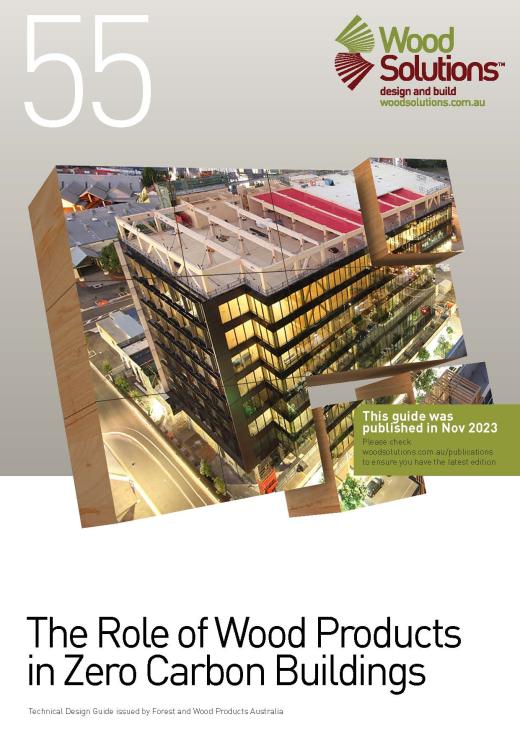Forest & Wood Products Australia’s Carbon Series provides high-level insights into the opportunities for timber and wood products in Australia’s built environment. This guide focuses on the role of wood products in zero carbon buildings, and is a valuable resource for design professionals wanting to specify wood products in sustainable buildings.
While not a comprehensive analysis, the intent of this publication is to provide high-level guidance on a broad range of topics relevant to the built environment, including: carbon in forestry and wood products; biogenic and fossil carbon; embodied greenhouse gas emissions in buildings and designing for net zero; embodied carbon policies; and green building frameworks and tools.
An overview of the different terms and definitions used in connection with carbon, greenhouse gas emissions and global warming is supplemented by a more complete Carbon Glossary at the end of the document.
Reducing embodied emissions in materials and construction is an essential step in decarbonising Australia’s built environment. The guide provides commentary on embodied carbon across the different stages of the building life cycle. It explains why embodied carbon is important, how it is measured, and the value of reducing upfront carbon while designing with whole-of-life carbon in mind.
An understanding of the global carbon cycle, the importance of sustainable forest management, and the difference between biogenic and fossil carbon provides useful context to aid design decisions concerning bio-based and fossil-based building materials. So too is the inherent ability of wood products to store carbon for long periods, in both the built environment and landfill.
The importance of life cycle assessments and environmental product declarations in assessing the environmental impacts of materials and design is supported by discussion of accounting for biogenic carbon in use and at end of life, and approaches to biogenic carbon in green building frameworks in Australia and New Zealand.
There are various design options available to reduce embodied carbon throughout the life cycle of a building. The guide surveys pathways to carbon zero design, considers an engineered timber future, lightweighting and end-of-life options for timber buildings. It concludes that smart design using wood products in structural systems can reduce fossil fuel use and cut greenhouse gas emissions. A brief discussion of the carbon-reduction opportunities available through digital fabrication and modular construction strengthens the argument.
A scan of Australia’s embodied carbon policies and frameworks, along with green building certifications and tools is provided in the closing sections of the guide.
Three recent Australian case studies located throughout the guide bring the discussion to life by illustrating some of the key topics covered in the guide and demonstrating that wood products can play an important role in the transition to zero carbon buildings.

The Role of Wood Products in Zero Carbon Buildings
This guide focuses on the role of wood products in zero carbon buildings, and is a valuable resource for design professionals wanting to specify wood products in sustainable buildings. While not a comprehensive analysis, the intent of this publication is to provide high-level guidance on a broad range of topics relevant to the built environment, including: carbon in forestry and wood products; biogenic and fossil carbon; embodied greenhouse gas emissions in buildings and designing for net zero; embodied carbon policies; and green building frameworks and tools.
